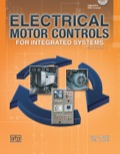Solutions for EBK ELECTRICAL MOTOR CONTROLS FOR INTEG
Browse All Chapters of This Textbook
Chapter 1.1 - Electrical TheoryChapter 1.2 - CircuitsChapter 1.3 - MagnetismChapter 1.4 - PowerChapter 2.1 - Language Of ControlChapter 2.2 - Electrical CircuitsChapter 3.1 - SafetyChapter 3.2 - General Use Test InstrumentsChapter 3.3 - Specialty Test InstrumentsChapter 4.1 - Electrical Safety
Chapter 4.2 - Lockout/tagoutChapter 4.3 - Personal Protective EquipmentChapter 4.4 - Fire SafetyChapter 4.5 - Confined SpacesChapter 4.6 - Overhead Power Line SafetyChapter 5.1 - Basic Rules Of Line DiagramsChapter 5.2 - Line Diagrams-signals, Decisions, And ActionsChapter 5.3 - Logic FunctionsChapter 5.4 - Common Control CircuitsChapter 5.5 - Control Circuit TroubleshootingChapter 6.1 - Industrial PushbuttonsChapter 6.2 - Selector SwitchesChapter 6.3 - JoysticksChapter 6.4 - Limit SwitchsChapter 6.5 - Foot SwitchesChapter 6.6 - Pressure SwitchesChapter 6.7 - Temperature SwitchesChapter 6.8 - Flow SwitchesChapter 6.9 - Level SwitchesChapter 6.10 - Preventing Problems When Installing Control DevicesChapter 7.1 - ElectromagnetsChapter 7.2 - SolenoidsChapter 7.3 - Solenoid CharacteristicsChapter 7.4 - Solenoid ApplicationsChapter 7.5 - Troubleshooting SolenoidsChapter 8.1 - Electromechanical RelaysChapter 8.2 - Types Of Electromechanical RelaysChapter 8.3 - Troubleshooting Electromechanical RelaysChapter 9.1 - Dc Generator ComponentsChapter 9.2 - Dc Generator TypesChapter 10.1 - Ac Generator ComponentsChapter 10.2 - Ac Generator TypesChapter 10.3 - Voltage ChangesChapter 11.1 - TransformersChapter 11.2 - Transformer ConnectionsChapter 11.3 - Transformer SelectionChapter 11.4 - Troubleshooting TransformersChapter 12.1 - Manual SwitchingChapter 12.2 - Manual ContactorsChapter 12.3 - Manual StartersChapter 12.4 - Magnetic ContactorsChapter 12.5 - Magnetic Motor StartersChapter 12.6 - Contactor And Magnetic Motor Starter ModificationsChapter 12.7 - Troubleshooting Contactors And Motor StartersChapter 13.1 - Dc Motor OperationChapter 13.2 - Dc Motor ConstructionChapter 13.3 - Dc Motor TypesChapter 13.4 - Stepper MotorsChapter 13.5 - Dc Motor Load RequirementsChapter 13.6 - Troubleshooting Dc MotorsChapter 14.1 - Ac Motor TypesChapter 14.2 - Ac Motor MaintenanceChapter 14.3 - Troubleshooting Ac MotorsChapter 15.1 - Reversing Motors Using Manual StartersChapter 15.2 - Reversing Motors Using Drum SwitchesChapter 15.3 - Reversing Motors Using Magnetic SwitchesChapter 15.4 - Magnetic Reversing Starter ApplicationsChapter 15.5 - Motor Control Wiring MethodsChapter 15.6 - Troubleshooting Reversing Power CircuitsChapter 16.1 - TimersChapter 16.2 - Timing FunctionsChapter 16.3 - Multiple-contact TimersChapter 16.4 - Troubleshooting Contact-based Timing CircuitsChapter 16.5 - Counters And TotalizersChapter 17.1 - Friction BrakesChapter 17.2 - PluggingChapter 17.3 - Electric BrakingChapter 17.4 - Dynamic BrakingChapter 18.1 - Understanding Motor Loads And Torque RequirementsChapter 18.2 - Power QualityChapter 18.3 - Motor LoadsChapter 18.4 - Motor Torque TypesChapter 18.5 - Open And Closed Circuit TransitionChapter 19.1 - Reduced-voltage StartingChapter 19.2 - Dc Motor Reduced-votlage StartingChapter 19.3 - Reduced-voltage Starting For Three-phase Induction MotorsChapter 19.4 - Primary Resistor StartingChapter 19.5 - Autotransformer StartingChapter 19.6 - Part-winding StartingChapter 19.7 - Wye-delta StartingChapter 19.8 - Starting Method ComparisonChapter 19.9 - Troubleshooting Reduced-voltage Starting CircuitsChapter 20.1 - RectifiersChapter 20.2 - Dc Power Supply FiltersChapter 20.3 - Voltage RegulatorsChapter 20.4 - Fuel CellsChapter 20.5 - Photovoltaic CellsChapter 20.6 - Troubleshooting Dc Power SuppliesChapter 21.1 - ThermistorsChapter 21.2 - Photoconductive CellsChapter 21.3 - Photoconductive DiodesChapter 21.4 - Pressure SensorsChapter 21.5 - Flow Detection SensorsChapter 21.6 - Hall Effect SensorsChapter 21.7 - Proximity SensorsChapter 21.8 - Ultrasonic SensorsChapter 22.1 - AmplificationChapter 22.2 - Operational AmplifiersChapter 22.3 - Field-effect TransisotrsChapter 22.4 - Troubleshooting Insulated Gate Bipolar TransistorsChapter 23.1 - Solid-state SwitchesChapter 23.2 - Silicon-controlled RectifiersChapter 23.3 - TriacsChapter 23.4 - DiacsChapter 23.5 - Unijunction TransistorsChapter 24.1 - Photoelectric DevicesChapter 24.2 - Photoelectric SensorsChapter 24.3 - Fiber OpticsChapter 24.4 - Photoelectric Sensor ApplicationsChapter 24.5 - Photoelectric Control ApplicationsChapter 25.1 - Solid-state RelaysChapter 25.2 - Electromechanical And Solid-state Relay ComparisonChapter 25.3 - Troubleshooting Solid-state RelaysChapter 25.4 - Solid-state Motor StartersChapter 26.1 - Motor DrivesChapter 26.2 - Programming Motor DrivesChapter 26.3 - Dc Motor DrivesChapter 26.4 - Ac Motor DrivesChapter 26.5 - Troubleshooting Motor Drive CircuitsChapter 27.1 - Programmable ControllersChapter 27.2 - Programmable Controller SectionsChapter 27.3 - Programmable Controller ApplicationsChapter 27.4 - Troubleshooting Programmable ControllersChapter 28.1 - Electrical Power DistributionChapter 28.2 - Distribution TransformersChapter 28.3 - Power Quality ProblemsChapter 28.4 - Smart GridsChapter 29.1 - Preventive Maintenance PrinciplesChapter 29.2 - AlignmentChapter 29.3 - BearingsChapter 29.4 - Flexible Belt DrivesChapter 29.5 - Prventive Maintenance TestsChapter 30.1 - Predictive Maintenance MonitoringChapter 30.2 - Maintenance Technicial Resources
Book Details
Electrical Motor Controls for Integrated Systems is the industry-leading reference that covers electrical, motor, and mechanical devices and their use in industrial control circuits. This textbook provides the architecture and content for acquiring the kn
More Editions of This Book
Corresponding editions of this textbook are also available below:
Electrical Motor Controls for Integrated Systems
5th Edition
ISBN: 9780826912268
Electrical Motor Controls for Integrated Systems Workbook
5th Edition
ISBN: 9780826912275
ELECTRICAL MOTOR CONTROLS F/INT..-TEXT
5th Edition
ISBN: 2810015115471
Electrical Motor Controls For Integrated Systems: Applications Manual
5th Edition
ISBN: 9780826912299
Electrical Motor Controls for Integrated Systems Applications Manual
4th Edition
ISBN: 9780826912206
ELECTRICAL MOTOR CONTROLS
4th Edition
ISBN: 9780826916716
Related Electrical Engineering Textbooks with Solutions
Still sussing out bartleby
Check out a sample textbook solution.
